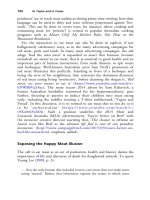The palgrave international handbook of a 231
Bạn đang xem bản rút gọn của tài liệu. Xem và tải ngay bản đầy đủ của tài liệu tại đây (28.92 KB, 1 trang )
226
J. Maher and T. Wyatt
or ‘mega diverse’ in biodiversity, this is not always the case. Russia, Canada, and
the US, for example, have lower levels of diversity, but still are the source of
some wildlife fuelling the black market (Wyatt 2013c).
China, the USA and the EU are thought to be the largest consumers of
illegal wildlife (McMurray 2008). The demand in China is for traditional
medicines, whereas in the USA and the EU consumers buy a diverse range of
wildlife from exotic companion animals and bird eggs to traditional medicines
and bushmeat (McMurray 2008). Using the CITES online trade database,
Wyatt (2013c) found that North America was responsible for 64 % of the
illegal imports reported to CITES in 2012. In contrast, the region only
accounted for 18 % of the illegal exports. Most illegal exports (28 % of the
total) originated in Asia, but surprisingly this region only accounted for 2 % of
the illegal imports reported to CITES—this clearly contradicts with the reports
from NGOs and academics. Europe’s illegal imports and exports were nearly
the same—21 % and 20 % respectively. Oceania and the Pacific (Australia,
New Zealand and the Pacific Island countries) are responsible for much
smaller portions—12 % of the illegal imports and 5 % of the illegal exports.
Central and South America including the Caribbean countries who are Parties
to CITES only had 1 % of illegal imports and then 12 % of illegal exports.
Finally, Africa illegally imported very little—1 %, but accounted for 17 % of
illegal exports. To reiterate, these can only be considered estimations due to the
secretive nature of the IWT and inconsistencies with measuring and recording
what is traded and confiscated. It is evidence though that every region of the
world is involved as both sources of and destinations for wildlife. Given these
estimations, questions must be raised over the sustainability of both the legal
and illegal trade? Additionally, how can the welfare of these animals be
adequately monitored and protected?
Wildlife, whilst being traded legally and illegally, is often subjected to
suffering and harm. The abuse that takes place occurs on two levels. As
Beirne (2007) has explored, human abuse of animals happens not only on an
individual basis but also on an institutionalised level. This is evident in many
contexts of human–animal relations such as instances of abuse of companion
animals as an example of individual level abuse and also at the institutional
level with the normalised legal abuse of ‘pets’ in government-funded scientific
experimentation (see chapters on ‘Physical Abuse’ and ‘The use of animals in
Medical Research’) Both levels of abuse are evident in the legal and illegal trade
as will be detailed in the next section, though it is impossible to estimate the
actual extent of harm the animals experience. First though, a discussion follows
on the organised nature of wildlife trafficking, which arguably enables the
abuse of a greater number of animal victims than the legal trade.









